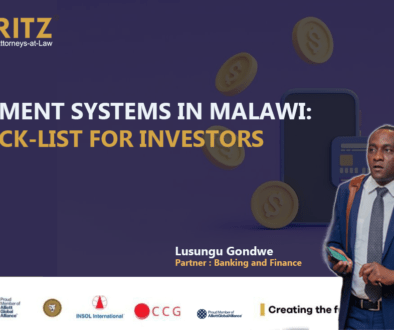by Lusungu Gondwe and Teuka Tembo
Conceptually green bonds are like any other debt instruments issued for purposes of raising finance. The distinctive features of green bonds are end utilization of the proceeds, process of selecting projects and assets, management of proceeds and process of reporting and external review.[1] Presently, Malawi has no regulations specifically addressing green bonds. Bond markets in Malawi hinge principally on the operation of the Securities Act, Companies Act and Public Private Partnership Act. None of the legislation or regulations made thereunder specifically address green bonds.
General requirements for issuance of debt securities may suffice for unlisted green bonds. This is the practice obtaining in other jurisdictions like India.[2] For listed green bonds, however, there is need for exhaustive guidelines. These guidelines must address the distinctive features of green bonds.
With respect to the use of proceeds, the regulatory framework must define green bonds.[3] This means that categories of what constitutes as “green” ought to be specifically identified. For example, generally accepted categories include renewable and sustainable energy, clean transportation, biodiversity conservation and climate change adaptation. This regulation removes uncertainty about what constitutes a green bond. Uncertainty can effectively deter investors. Clearly defined categories would also deter allegations that green bonds are not in fact, related to projects that are green. The International Finance Corporation and the World Bank propose globally accepted definitions of green bonds that can be incorporated in the formulation of the green bond regulation in Malawi.
Regarding project evaluation and selection, there ought to be disclosure requirements.[4] For example, disclosures about the eligibility criteria of projects, details about processes followed for determining if projects meet the eligibility criteria and disclosures about environmental objectives of the issuance of green debts are necessary to ensure the credibility of green bonds. As has been adopted in other jurisdictions like India, the regulatory framework could require independent third-party review of the issuance process. Such requirements remove uncertainty about the issuance process and enhance the credibility of the green bonds market.
The third distinctive feature that ought to be addressed by the regulatory framework in Malawi is management of proceeds.[5] The regulatory framework must include monitoring measures for green bonds. As stated above, green bonds are like any other bonds except proceeds are intended for use in financing projects that deliver environmentally friendly benefits. The interest of an issuer is therefore not limited to the eligibility of a project at the point of issuing the bond but also in the continued eligibility of the project. Monitoring requirements are therefore indispensable in the green bonds market. For example, green bond issuers can be mandated to disclose how they will track proceeds and these tracking procedures can be subjected to verification by external independent auditors. With respect to reporting and external review, green bond issuers must be mandated to fulfil certain reporting benchmarks.[6] For example, issuers can be required to give details about projects to which green bonds proceeds have been allocated and their environmental benefits.
The regulatory framework can therefore establish performance indicators at periodic intervals. Not only does this promote the credibility of the green bonds market, but also promotes its durability by facilitating prolonged stakeholder engagement and trust.
The utility of raising finance through green bonds is undeniable in view of countries’ obligations to meet sustainable development goals[1]. It is therefore prudent to create the necessary regulatory framework. Only a robust framework that guarantees that proceeds are directed towards desired projects will give investors confidence in Malawi’s green bonds market. Presently, Malawi’s regulatory framework is designed to regulate conventional bonds. It does not anticipate the distinctive features of green bonds. A green bond market under the present regulatory framework would lack credibility which would be detrimental to its growth.
[1] Lloyd Freeburn and Ian Ramsay, “Green bonds: legal and policy issues” (2020) 15(4) Capital Markets Law Journal, 418-442.




